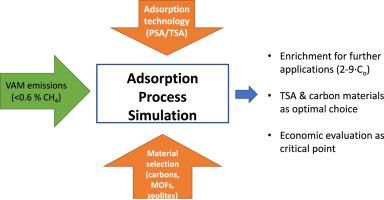Gas Science and Engineering ( IF 5.285 ) Pub Date : 2022-07-19 , DOI: 10.1016/j.jngse.2022.104721 David Ursueguía , Eva Díaz , Salvador Ordóñez

|
This work evaluates the feasibility of common adsorbents (carbonaceous materials, zeolites and metal-organic frameworks) for the adsorption and further methane upgrading of the ventilation air methane (VAM) emissions from underground coal mining (0.57% CH4). Concentration was achieved by adsorption through two different operational procedures based on fixed bed configurations: temperature swing adsorption (TSA) and pressure swing adsorption (PSA). All the combinations have been simulated using a rigorous mathematical model implemented in a commercial simulation package. The main purpose is to evaluate the performance of the different combinations of adsorption technique and adsorbent material, as well as establishing a valid mathematical model able to test a wide range of materials. The comparison has been fulfilled with an economic evaluation of the different combinations. Results show that carbonaceous materials provide the highest concentration factors (C/C0 = 5), with low total methane recoveries (30%) and the lowest cost per kmol of methane recovered (1.5 €/kmol). MOFs can retain substantial amounts of methane, but with lower CH4/N2 selectivities than carbonaceous materials and lower methane concentration factors (C/C0 = 2.6). For this type of materials, a high recovery of methane is achieved, but at expense of the highest costs (80 €/kmol). Finally, zeolitic materials present the lowest methane concentration factor (C/C0 = 2), with intermediate both methane recoveries (58%) and costs (25 €/kmol). Concerning the adsorption technique, TSA has shown higher final methane concentrations for carbonaceous materials and some MOFs, whereas PSA overperforms for zeolitic materials. In addition, TSA is cheaper in all cases than PSA processes. On the other hand, PSA allows higher total methane recoveries and adsorption capacities for all materials, highlighting the high dependence on adsorption pressure, especially in carbonaceous materials (PSA/TSA = 18.3, in the case of Maxsorb).
中文翻译:

变温变压吸附技术富集低品位瓦斯煤矿排放的吸附剂选择
这项工作评估了普通吸附剂(碳质材料、沸石和金属有机骨架)对地下采煤通风空气甲烷 (VAM) 排放(0.57% CH 4)。通过基于固定床配置的两种不同操作程序的吸附实现浓缩:变温吸附 (TSA) 和变压吸附 (PSA)。所有组合都使用商业模拟包中实施的严格数学模型进行了模拟。主要目的是评估吸附技术和吸附材料的不同组合的性能,以及建立能够测试各种材料的有效数学模型。通过对不同组合的经济评估完成了比较。结果表明,含碳材料提供了最高的浓缩因子(C/C 0 = 5),总甲烷回收率低 (30%),每 kmol 甲烷回收成本最低 (1.5 €/kmol)。MOF 可以保留大量的甲烷,但其 CH 4 /N 2选择性低于碳质材料和甲烷浓度因子(C/C 0 = 2.6)。对于这种类型的材料,甲烷的回收率很高,但代价是最高的成本(80 欧元/kmol)。最后,沸石材料具有最低的甲烷浓度因子(C/C 0 = 2),甲烷回收率 (58%) 和成本 (25 €/kmol) 均处于中等水平。关于吸附技术,TSA 对含碳材料和一些 MOF 显示出更高的最终甲烷浓度,而 PSA 对沸石材料的性能优于其他材料。此外,在所有情况下,TSA 都比 PSA 工艺便宜。另一方面,PSA 允许所有材料的总甲烷回收率和吸附容量更高,突出了对吸附压力的高度依赖性,尤其是在碳质材料中(对于 Maxsorb,PSA/TSA = 18.3)。


























 京公网安备 11010802027423号
京公网安备 11010802027423号